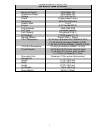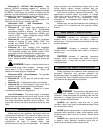
7
are easier to start and usually require 2 to 4 times as much
current to start than to run. Repulsion Induction motors
are the easiest to start and require 1.5 to 2.5 times as
much to start than to run.
Most fractional motors take about the same amount of
current to run them whether they are of Repulsion-
Induction (RI), Capacitor (Cap), or Split-Phase (SP) type.
The following chart shows the approximate current
required to start and run various types and sizes of 120
volt 60 cycle electric motors under various conditions.
120V, 60 Hz Motors
Starting Amps
Hp motor Running
Watts
RI type Cap type SP type
1/6 525 7-11 9-18 16-22
1/4 700 9-15 12-23 22-32
1/3 875 11-18 14-29 26-35
1/2 1175 15-25 20-40 NA
1 1925 24-40 32-64 NA
1 1/2 2400 30-50 40-80 NA
2 2900 36-60 48-96 NA
3 4075 51-85 68-136 NA
5 6750 84-140 112-224 NA
The figures given above are for an average load such
as a blower or fan. If the electric motor is connected to a
hard starting load such as an air compressor, it will require
more starting current. If it is connected to a light load or no
load such as a power saw, it will require less starting
current. The exact requirement will also vary with the
brand or design of the motor.
Generators respond to severe overloading differently
than the power line. When overloaded, the engine is not
able to supply enough power to bring the electric motor up
to operating speed. T he generator responds to the high
initial starting current, but the engine speed drops sharply.
The overload may stall the engine. If allowed to operate at
very low speeds, the electric motor starting winding will
burn out in a short time. The generator head winding
might also be damaged.
Running the generator under these conditions may
result in damage to the generator stator as well as the
motor windings. Because the heavy surge of current is
required for only an instant, the generator will not be
damaged if it can bring the motor up to speed in a few
seconds. If difficulties in starting a motor are experienced,
turn off all other electrical loads and if possible reduce the
load on the electric motor.
EXTENSION CORDS
When electric power is to be provided to various loads
at some distance from the generator, extension cords can
be used. These cords should be sized to allow for
distance in length and amperage so that the voltage drop
between the set and point of use is held to a minimum.
Current/Power Maximum Extension Cord Length
Amps
at
240V
Load
(watts)
#10
Ga.
Cord
#12
Ga.
Cord
#14
Ga.
Cord
#16
Ga.
Cord
10 2400 250’ 150’ 100’ 75’
20 4800 125’ 75’ 50’ 25’
30 7200 60’ 35’ 25’ 10’
40 9600 30’ 15’ 10’ *
50 12000 15’ * * *
*Not recommended
CAUTION: Equipment damage can result from the low
voltage caused by using an extension cord with a small
wire size.
Use this chart to estimate the total load on your
generator.
For Determining Generator Load Requirements
Dev ice Running Watts
Air Conditioner (12,000 Btu) 1700 (a)
Battery Charger (20 Amp) 500
Belt Sander (3”) 1000
Chain Saw 1200
Circular Saw (6-1/2”) 900
Coffee Maker 1000
Compressor (1 HP) 2000 (a)
Compressor (3/4 HP) 1800 (a)
Compressor (1/2 HP) 1400 (a)
Curling Iron 700
Dishwasher 1200
Edge Trimmer 500
Electric Nail Gun 1200
Electric Range (one element) 1500
Electric Skillet 1250
Freezer 800 (b)
Furnace Fan (1/3 HP) 1200 (a)
Hair Dryer 1200
Hand Drill (1”) 1100
Hand Drill (1/2”) 875
Hand Drill (3/8”) 500
Hand Drill (1/4”) 250
Hedge Trimmer 450
Home Computer 150
Impact Wrench 500
Jet Pump 800 (a)
Lawn Mower 1200
Light Bulb 100
Microwave Oven 700
Load Requirements Continued
Milk Cooler 1100 (a)
Oil Burner on Furnace 300
Oil Fired Space Htr (140,000 Btu) 400
Oil Fired Space Htr (85,000 Btu) 225
Oil Fired Space Htr (30,000 Btu) 150
Oven 4500
Paint Sprayer, Airless (1/3 HP) 600 (a)
Paint Sprayer, Airless (handheld) 150
Radio 200
Refrigerator 600 (b)













